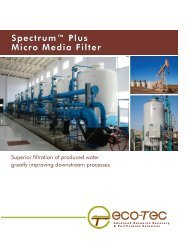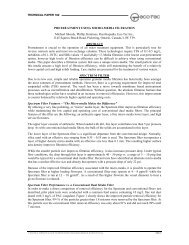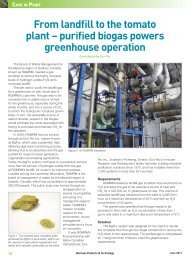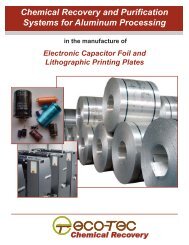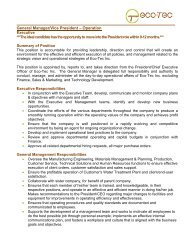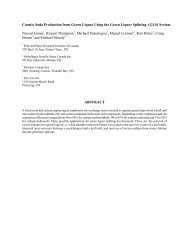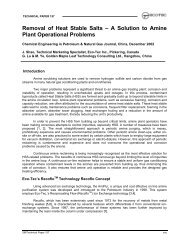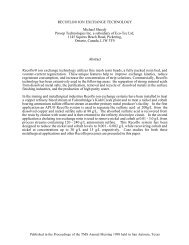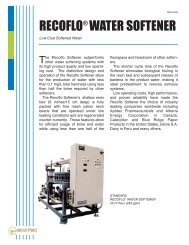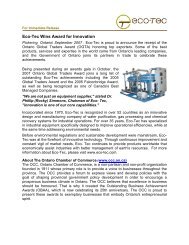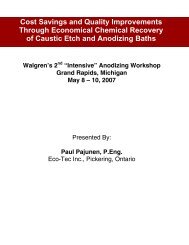GENERATOR ACID PURIFICATION - Eco-Tec
GENERATOR ACID PURIFICATION - Eco-Tec
GENERATOR ACID PURIFICATION - Eco-Tec
Create successful ePaper yourself
Turn your PDF publications into a flip-book with our unique Google optimized e-Paper software.
Chemical Recovery<br />
of Caustic Etch<br />
and<br />
Anodizing Baths<br />
COST SAVINGS<br />
& QUALITY IMPROVEMENTS<br />
presented<br />
at the<br />
1st Annual<br />
"Intensive"<br />
Equipment Workshop<br />
2002<br />
Grand Rapids,<br />
Michigan<br />
by<br />
Paul Pajunen, P.<br />
Eng.<br />
E T I<br />
INTRODUCTION<br />
Aluminum is anodized using water-based chemicals that can be treated in a fairly straightforward<br />
manner. However, many plants now use recycling equipment to extend chemical life and reduce waste<br />
treatment costs. This is due, in part, to the large amount of solid waste that etching and anodizing<br />
generates. As most methods of recycling involve some degree of purification, anodizers often find that<br />
quality improvements go hand in hand with chemical savings.<br />
It is well known that etching and anodizing generates large volumes of aluminum hydroxide sludge.<br />
Recycling reduces this waste, lowers chemical costs, and, frequently, improves product quality. For<br />
example, processing 1,000 ft 2 of anodized surface area, weighing about 400 lb, down a typical<br />
architectural anodizing line can result in 420 lb of aluminum hydroxide sludge eventually being produced<br />
in waste treatment. 1 lb of aluminum processed can result in 1 lb of aluminum sludge being produced.<br />
Implementing recovery techniques can potentially result in an 85% reduction of waste sludge being<br />
generated.<br />
Three recovery techniques will be reviewed that are commonly used to regenerate the caustic soda<br />
etching bath, recover phosphoric acid bright dip solution from rinsewater, and purify the sulfuric acid<br />
anodizing bath.<br />
1 st Annual “Intensive” Equipment Workshop 1 October 2002
1. CAUSTIC ETCH RECOVERY<br />
Etching is caused by a reaction between the aluminum and caustic soda that produces sodium aluminate<br />
and hydrogen gas as follows:<br />
etching reaction<br />
2Al + 2NaOH ----> 2NaAlO 2 + 3H 2 (gas)<br />
The etching process is typically responsible for 80-90% of aluminum in the waste treatment system.<br />
Chemical stabilizers (complexing agents) are added to prevent the aluminum from precipitating out in the<br />
etch tank. The additives thicken the solution to the point where enough liquid is carried out on the parts<br />
to keep the aluminum level from building up in this "never dump" etch. Rinsing carries dissolved<br />
aluminum and caustic to the plant waste treatment system.<br />
If complexing agents are not used and the sodium aluminate concentration is allowed to rise too high, it<br />
will hydrolyze to produce alumina tri-hydrate (Al 2 O 3<br />
. 3H2 O), thereby liberating free caustic soda.<br />
hydrolysis reaction<br />
2 NaAlO 2 + 4H 2 O ---> 2 NaOH + Al 2 O 3<br />
. 3H2 O<br />
This reaction, known as the Bayer process, is used in the primary aluminum industry to make alumina. If<br />
not properly controlled, it leads to an accumulation of a rock-hard aluminum hydroxide scale in the etch<br />
tank. By seeding the etch solution with alumina crystals in a separate crystallizer tank, it is possible to<br />
regenerate the etch solution without having scale buildup.<br />
The basic operation of a regeneration system is such that etch solution is recirculated continuously<br />
between the etch tank and the crystallizer tank. Hydrated alumina crystals form in a slurry section of the<br />
crystallizer and settle out in the clarification section. Regenerated etch solution, with reduced aluminum<br />
and increased free caustic levels, flows back to the etch bath directly from the top of the crystallizer.<br />
Alumina crystals are withdrawn periodically from the bottom of the crystallizer and dewatered in a filter<br />
press.<br />
Over the past ten years many large architectural anodizers have installed regeneration systems based on<br />
this process. Regeneration can reduce a plant's solid waste by over 80% while lowering caustic<br />
chemical costs by over 70%. The crystals, which are removed, have a variety of uses as an alumina<br />
substitute.<br />
One issue pertaining to a regenerated etch relates to its lower aluminum levels. As high aluminum levels<br />
promote a more matte finish, there were initially some concerns that a regenerated etch would not yield a<br />
suitable finish. With dozens of systems now in operation in North America, a regenerated etch is<br />
regarded to produce a finish slightly less matte than a "never-dump" finish but satisfactory for most<br />
applications.<br />
1 st Annual “Intensive” Equipment Workshop 2 October 2002
2. SULFURIC <strong>ACID</strong> ANODIZING <strong>PURIFICATION</strong><br />
The anodizing operation itself represents an excellent opportunity for purification. By the time the<br />
aluminum level in the acid reaches 15-20 g/L, the solution is decanted or dumped. In addition to<br />
eliminating a waste problem, continuous purification can enhance the uniformity of the anodized film.<br />
Operating an anodizing bath in a dump/decant manner presents a number of potential problems. These<br />
become apparent due to the fact that there exists a delicate balance within an anodizing bath - namely,<br />
the relationships between the electrical resistance (caused by the formed oxide coating and the<br />
anodizing solution conductivity), the voltage being applied, and the desired constant current condition.<br />
The electrical resistance increases relative to the thickness of the oxide coating and to the increasing<br />
aluminum concentration in the anodizing solution. To compensate for this increased resistance, the<br />
rectifier voltage must be increased in order for the current to remain constant. Adding in other variables<br />
such as bath temperature, degree of solution agitation, and sulfuric acid concentration can result in<br />
upsets and potentially lead to a decline in product quality.<br />
Maintaining a consistent, low aluminum concentration removes or minimizes a variable that can affect the<br />
balance between resistance, voltage, and current. Controlling the aluminum concentration and recovery<br />
of sulfuric acid for continued use in the aluminum finishing industry has been practiced for a number of<br />
years. The end result is ensuring a consistent, predictable bath operation leading to cost savings and<br />
improved product quality.<br />
A popular method of acid recovery employs a process called acid sorption (APU). Acid sorption<br />
technology employs specially treated ion exchange resins that have the ability to sorb free (unused)<br />
mineral acids while rejecting the salts (e.g. aluminum sulfate) of these acids. The most unique feature of<br />
these resins is their ability to release the acid with a simple water wash.<br />
1 st Annual “Intensive” Equipment Workshop 3 October 2002
3. BRIGHT DIP RECOVERY<br />
Concentrated phosphoric acid solutions, usually with additions of nitric acid, diammonium phosphate and<br />
copper, are used to chemically brighten aluminum parts. After brightening, the adhering solution must be<br />
rinsed off immediately with water. Due to the high acid concentrations and viscosities of bright dip baths,<br />
carryout of bath solution on the parts is typically 3-4 times greater than from an anodizing tank. While<br />
aluminum contamination of the bath is rarely a problem, there is a substantial loss of bath chemicals.<br />
Most plants collect the rinsewater as a 35% solution for resale as fertilizer. The seasonal and regional<br />
variations in demand for the rinsewater reduce the value to between 10-20% of the original chemical<br />
cost.<br />
The rinse can be reconcentrated to bath strength with a vacuum evaporator; however, a purification step<br />
must be employed to prevent aluminum buildup. A combination cation exchanger resin bed and an acid<br />
sorption resin bed undertakes this purification step. This combination is known as a DPU. The cation<br />
resin bed removes about 90% of the aluminum before the solution flows to the evaporator, This resin<br />
bed is regenerated with sulfuric acid and the waste, containing sulfuric acid and aluminum, is processed<br />
with the sorption resin bed. Purified sulfuric acid is maintained within the system for use in the next<br />
regeneration cycle.<br />
By using the DPU system, the cost of operation is reduced to the point where recovery becomes<br />
economical for any plant consuming more than three truckloads per month of 80% acid. Several<br />
installations have been installed over the last fifteen years and, in all cases, acid recovery efficiencies in<br />
excess of 85% have been reported.<br />
CONCLUSION<br />
With the increased focus on environmental concerns in all facets of business, anodizers can look at a<br />
number of opportunities in their plants that will reduce process chemical costs, reduce waste treatment<br />
chemical and labor costs, and, in many cases, enhance product quality. Recycling is an environmentally<br />
pro-active step that demonstrates a responsible corporate image to your customers, employees, and to<br />
the local authorities.<br />
1 st Annual “Intensive” Equipment Workshop 4 October 2002



